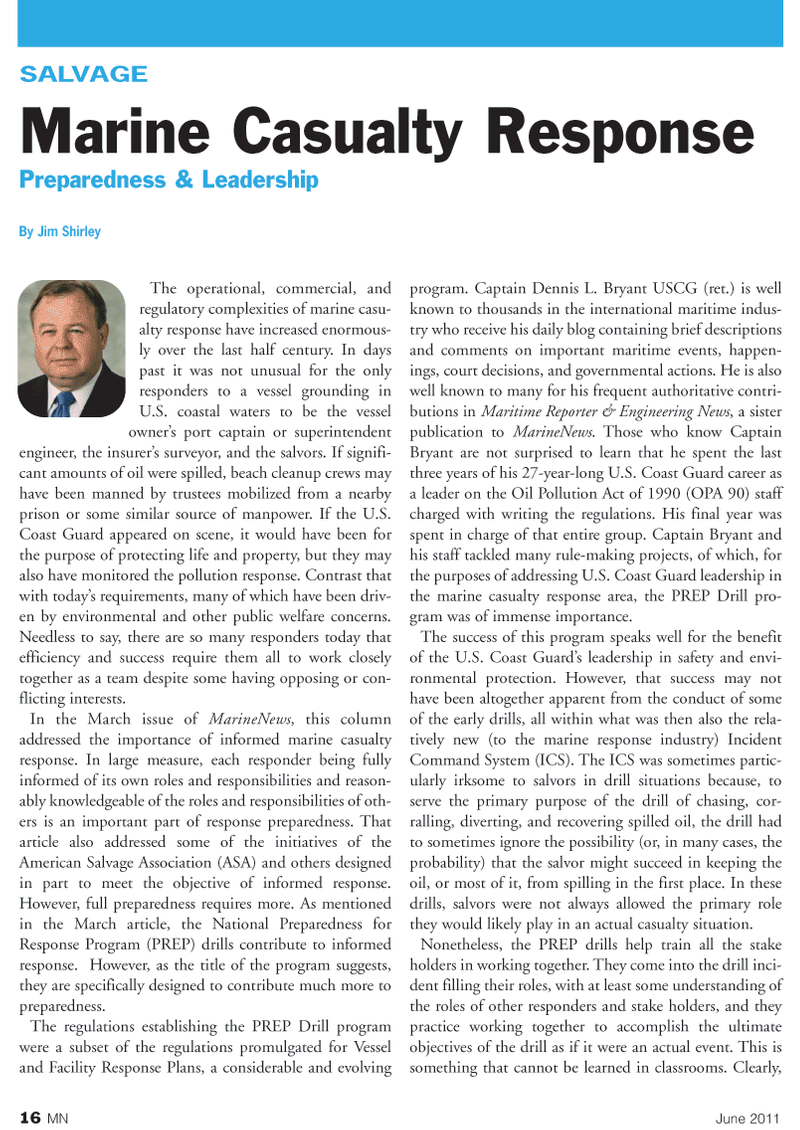
Page 16: of Marine News Magazine (June 2011)
CEO Six-Pack: The Leadership Edition
Read this page in Pdf, Flash or Html5 edition of June 2011 Marine News Magazine
16 MN June 2011
SALVAGE
The operational, commercial, and regulatory complexities of marine casu- alty response have increased enormous- ly over the last half century. In days past it was not unusual for the only responders to a vessel grounding in
U.S. coastal waters to be the vessel owner’s port captain or superintendent engineer, the insurer’s surveyor, and the salvors. If signifi- cant amounts of oil were spilled, beach cleanup crews may have been manned by trustees mobilized from a nearby prison or some similar source of manpower. If the U.S.
Coast Guard appeared on scene, it would have been for the purpose of protecting life and property, but they may also have monitored the pollution response. Contrast that with today’s requirements, many of which have been driv- en by environmental and other public welfare concerns.
Needless to say, there are so many responders today that efficiency and success require them all to work closely together as a team despite some having opposing or con- flicting interests.
In the March issue of MarineNews, this column addressed the importance of informed marine casualty response. In large measure, each responder being fully informed of its own roles and responsibilities and reason- ably knowledgeable of the roles and responsibilities of oth- ers is an important part of response preparedness. That article also addressed some of the initiatives of the
American Salvage Association (ASA) and others designed in part to meet the objective of informed response.
However, full preparedness requires more. As mentioned in the March article, the National Preparedness for
Response Program (PREP) drills contribute to informed response. However, as the title of the program suggests, they are specifically designed to contribute much more to preparedness.
The regulations establishing the PREP Drill program were a subset of the regulations promulgated for Vessel and Facility Response Plans, a considerable and evolving program. Captain Dennis L. Bryant USCG (ret.) is well known to thousands in the international maritime indus- try who receive his daily blog containing brief descriptions and comments on important maritime events, happen- ings, court decisions, and governmental actions. He is also well known to many for his frequent authoritative contri- butions in Maritime Reporter & Engineering News, a sister publication to MarineNews. Those who know Captain
Bryant are not surprised to learn that he spent the last three years of his 27-year-long U.S. Coast Guard career as a leader on the Oil Pollution Act of 1990 (OPA 90) staff charged with writing the regulations. His final year was spent in charge of that entire group. Captain Bryant and his staff tackled many rule-making projects, of which, for the purposes of addressing U.S. Coast Guard leadership in the marine casualty response area, the PREP Drill pro- gram was of immense importance.
The success of this program speaks well for the benefit of the U.S. Coast Guard’s leadership in safety and envi- ronmental protection. However, that success may not have been altogether apparent from the conduct of some of the early drills, all within what was then also the rela- tively new (to the marine response industry) Incident
Command System (ICS). The ICS was sometimes partic- ularly irksome to salvors in drill situations because, to serve the primary purpose of the drill of chasing, cor- ralling, diverting, and recovering spilled oil, the drill had to sometimes ignore the possibility (or, in many cases, the probability) that the salvor might succeed in keeping the oil, or most of it, from spilling in the first place. In these drills, salvors were not always allowed the primary role they would likely play in an actual casualty situation.
Nonetheless, the PREP drills help train all the stake holders in working together. They come into the drill inci- dent filling their roles, with at least some understanding of the roles of other responders and stake holders, and they practice working together to accomplish the ultimate objectives of the drill as if it were an actual event. This is something that cannot be learned in classrooms. Clearly,
Marine Casualty Response
Preparedness & Leadership
By Jim Shirley

 15
15

 17
17
